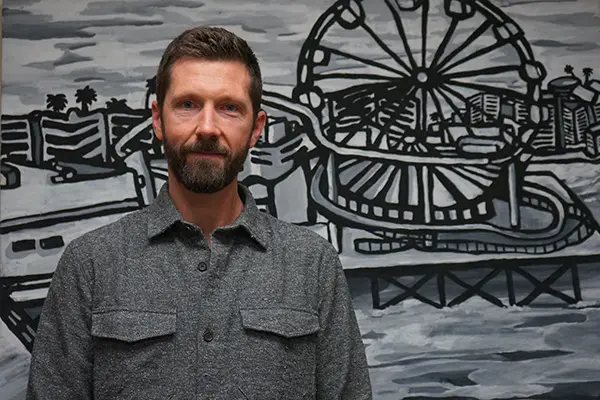Schneider Works on Better Measures of School Quality
 Image by K. Webster
Image by K. Webster
01/14/2019
By Katharine Webster
Are America’s public schools failing their students? Asst. Prof. of Education Jack Schneider, a former history teacher turned education historian, says the evidence shows that most of them are not.
In fact, research shows public schools have improved over the last few decades in most places, despite what Schneider describes as ill-conceived, top-down “reform” efforts, funding cuts and a drumbeat of alarmist rhetoric.
Schneider, who has written three books on education policy and co-hosts a popular education podcast, “Have You Heard?”, is director of research for the Massachusetts Consortium for Innovative Education Assessment, a group of seven very different school districts that is developing alternatives to the state’s measurement and accountability system. The consortium grew out of Schneider’s efforts to help the Somerville schools develop fair and comprehensive measures of school quality, informed by community values.
Schneider teaches graduate students in the College of Education about policy, leadership and curriculum design and assessment. A frequent contributor to The Washington Post, The Atlantic and The Conversation, he hopes to improve the public’s understanding of the challenges facing public education. He was just named by Education Week as one of the 200 education scholars nationwide who did the most to shape educational practice and policy in 2018.
Q: You wrote a column for The Washington Post recently that highlights the widening gap between what Americans think of public schools overall – that they’re failing – versus what they think of their own public schools, which is that they’re pretty good. Why such a big discrepancy?
A: Americans’ faith in public education overall has declined steeply since the 1970s. Yet most Americans think their own children’s schools are doing a pretty good job, and research on educational achievement bears that out. There’s significant evidence that the perception gap is a product of limited data – chiefly standardized test scores – and alarmist political rhetoric. Because Americans generally have more information about their own community’s schools, they have a more realistic picture of local school quality.
Q: Why do you oppose using standardized test scores to rate schools and teachers?
A: High-stakes, mandatory testing limits what schools can focus on, and it forces teachers to waste a lot of class time on practice tests, as well as the actual tests. And standardized test scores are just not a good way of measuring school performance.
Rigorous, unbiased research shows that the chief predictors of high test scores are family income, parents’ education and race – factors that have nothing to do with school quality. In other words, students in mostly white, wealthy communities with a high percentage of college-educated parents do better on standardized tests. Yet many schools designated as “low-performing” have committed, high-quality teachers, a strong curriculum and engaged students who are growing and learning.
 Image by Bob Duffy
Image by Bob Duffy
Q: The consortium promotes a comprehensive, holistic model for assessment. What’s included in that, and are MCAS scores (Massachusetts’ standardized test) part of it?
A: Our model looks at teacher and school leader qualifications and practices; the school culture, meaning whether a school is safe, caring and academically oriented; school resources; student participation and other measures of community and wellness; and academic outcomes. We incorporate existing state data, and we collect a great deal of our own data.
Right now, we include improvement in MCAS scores as part of our appraisal of academic outcomes, although we plan to move away from the MCAS altogether in favor of comprehensive performance assessments. For example, under the guidance of the Center for Collaborative Education, teachers in a Revere school evaluated their fourth-graders’ math and problem-solving skills by asking them to design a school playground. The students had to take measurements, draw up plans, keep their equipment purchases within a budget and then present their proposals. They didn’t even know they were being tested.
Q: Using standardized tests to rate school performance is the biggest legacy of the No Child Left Behind Act. In your view, did the law have any positive effects?
A: No Child Left Behind was widely viewed by critics, mostly educators and scholars, as an unfunded mandate and a major overreach – one that had some pretty devastating unintended consequences. Still, it accomplished two important things, both of which are still in effect.
The law mandated transparency in school performance reporting, even if the measures being reported – mostly standardized test scores – aren’t the best way to measure schools.
No Child Left Behind also required schools to break down the data they report by student subgroup: low-income, special needs, English language learners and different racial groups. That means that schools have to pay attention to all of their students; they can’t just write off certain groups.
Q: What’s your next book about?
A: It’s about the history and tactics of a decades-old movement to undermine the public education system and replace it with a private, market-based system. That movement has become more visible with the appointment of Betsy DeVos as U.S. education secretary, but its roots go much deeper.
The movement’s leaders have a deep faith in market competition and privatization. They emphasize individuals and private goods rather than communities and collective goods. They also want to break up teacher unions and cut costs, even when those cuts come at the expense of the most vulnerable children.
A lot of the policies they push for, such as private school vouchers, for-profit charter schools and virtual schools, don’t seem as problematic on the surface as they really are. For example, the political rhetoric about school vouchers is that they will empower low-income and minority families to choose better schools, when the real intent – at least among the ideologically hard-core – is to drain needed resources from public schools that accept all students. Unfortunately, effective messaging has hidden the underlying agenda from view. The chief goal of the book is to bring that agenda to the surface.
Q: It seems like there’s been some pushback against that agenda recently, including broad public support for teacher strikes in West Virginia, Oklahoma and Arizona. Why is that, given that teacher unions are often viewed as a barrier to school improvement?
A: The ideological movement to dismantle public education has not been upfront and direct because most Americans, regardless of political affiliation, have a strong attachment to public schools. Public education enjoys bipartisan support because 90 percent of us went to public schools and send our children to them.
The hard-core ideologues and their followers have encouraged Americans to view teacher unions as advocating for better working conditions for themselves, at taxpayer expense – higher salaries, more jobs, better professional development and more resources. And that’s partly true. But the conditions that create a good and sustainable teaching profession also create better learning conditions for children, because if we have high rates of teacher turnover, undertrained teachers and teachers overburdened with large class sizes, we’re going to have problems in schools.
Thanks in part to the 2018 teacher strikes and teachers campaigning for political office, there’s a rising public awareness that public schools have been under siege – and that teacher unions are fighting for improvements to the quality of our children’s education.



